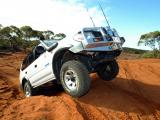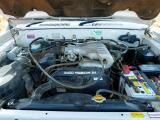Prado Perfection
PROS
- Reliability
- Choice
- Comfort
CONS
- Small size
- Expensive to buy
- Expensive to run
The Prado was an instant hit when released in 1996, with Toyota selling over 2500 in its first six months. This figure more than doubled in the following 12 months and has continued to rise, with 2009 seeing over 13,000 sold.
The Prado was an excellent alternative to those who wanted a reliable 4WD that didn’t have the larger dimensions of the 100 Series LandCruiser. It was a direct answer to the successes that Mitsubishi and Land Rover had been having with the Pajero and Discovery respectively. The formula was simple: make a vehicle that was comfortable for the road and capable off it. It immediately gained popularity with the school-run mums as much as it did with serious 4WDers, if not more so.
This is great news, as it means that there are plenty of un-abused examples to chose from. So how do you make sure you get a good one?
ABOUT THE PRADO
The Prado improved on the short-wheelbase 70 Series platform that sold between 1985 and 1991 as the Bundera. It spun off to create the 90 Series and received the name LandCruiser Prado. The 90 Series was designed as a more luxurious evolution of the Bundera/70 Series platform.
The Prado design stuck with the proven set-up on the Bundy with coil springs fitted to both the front and rear. The Prado was different in the fact that it used an independent front set-up rather than a solid axle. This gave the Prado better on-road manners than the Bundera it replaced.
In Australia, the Prado was released as the 95 Series. The new, at the time, Prado also came with engine updates, offering a choice of a four-cylinder 2694cc or V6 3378cc petrol. Strangely, the Bundera’s run ended in 1991 with a 2446cc turbo diesel option, but no diesel was available when the 95 Series launched. It took Toyota until 2003 to introduce the 1KZ-TE 2982cc turbo-diesel engine. These petrol and diesel engines were the only choices available during the seven years of sales.
Throughout the life of the 95 Series, there were constant updates and revisions to specifications and equipment levels, with only the one significant update in 1999. The update saw some changes to the looks, with a deeper front bumper, new radiator grille, clear rear light cluster, and a black-on-white rear name badge. Interior trims were improved and a new instrument layout with an electronic odometer was introduced.
The Prado was available with a whole host of optional Toyota accessories, including a range of off-road-specific upgrades. When buying a used 90 Series, look out for genuine items such as bullbars, snorkels, dual battery systems, diff locks, and winches. Let’s check out what else to look for when buying a used Prado.
MECHANICALS
The Prado is blessed with Toyota reliability and there isn’t a lot that goes wrong in a well cared for example.
The 2.7L, 3RZ-FE petrol engine has a cast-iron block and aluminium cylinder head.
The valves in this engine can be prone to burn damage. This is generally caused by the valves wearing and not contacting the cylinder head properly, which leads them to overheat.
It is essential to ensure that regular servicing has included valve clearance checks to reduce the risk of getting stung for the cost of replacing valves. Compression testing can help show up faults.
The petrol V6, 5VZ-FE engine also has a cast iron block with twin aluminium cylinder heads. Each cylinder head has two camshafts, giving the engine a quad-cam title.
The standard engne is in a low state of tune, so faults with well-serviced examples are very rare. High-km engines are fine if they are well looked after and serviced regularly, so expect to get to 250,000km plus before seeing any rebuild issues.
In post 1999 petrol models, the mass air flow meter (MAF) can cause poor running from dirt covering the ‘hot-wire’ sensor. This is easily rectified by removing the MAF and cleaning it with a specific cleaning product.
The diesel 1KZ-TE engine is prone to cracking the cylinder heads when it overheats, so make sure the cooling system is in perfect working order.
Timing belts/chains should be changed every 100,000km in petrol engines and 150,000km in diesel engines, but double-check the schedules in the owner’s manual/servicing book. Getting the timing belt/chain changed is not a cheap job, so if the Prado you are buying is getting close to a scheduled belt change, then negotiate a drop in the seller’s price. When buying a used vehicle it is always worth changing the belt or chain unless you can be certain that it was done recently. It may cost you a few hundred dollars, but it’s a lot cheaper than a full engine rebuild should the belt/chain fail.
The viscous fan fitted to the 95 Series generally has a lifespan of around 200,000km and a tired old unit will seriously compromise the cooling system’s ability to cool.
Unless you have documented evidence that the unit has been replaced and the kilometres are high, then this should also be factored into any purchase price.
The suspension in the 95 Series Prado is well set up for good manners both on and off-road. Have a close look at the springs and shocks at every corner of the vehicle.
The springs should be inspected to make sure that none are broken or cracked. The shocks are gas, so there will be no sign of oil to determine whether they are leaking or not. A rough way to check their operation is to push down on each corner, one at a time, and then quickly let go. The suspension should quickly settle to normal levels. If it bounces up and down, then you could have worn shocks. If you have any doubts, then the vehicle should be tested by a suspension specialist.
The 95 Series Prado is prone to wear in the steering rack in two places. The first is the actual mounting bushes for the entire steering rack. These can be replaced with standard rubber bushes, but there are also urethane replacements that last longer.
The second area is where the tie rods meet the steering rack. With the vehicle parked and the engine switched off, rock the steering wheel from left to right and feel for any unusual clunks. You would also feel this while driving the vehicle, particularly when turning sharply from one lock to another at low speed. This also isn’t a major job, but requires the wheel alignment to be accurately reset and if left untreated will cause damage to the rack itself – a very costly fix.
The Prado really does have excellent build quality and most issues are signs of wear and tear, neglect, or abuse. If you find a good example, it can last a lifetime with very few worries.
BODY AND INTERIOR
The Prado was designed by Toyota to compete with the other medium-sized 4WDs. The Pajero and Discovery had a head start, but were soon being overtaken in the sales charts by the Prado. This was, in part, down to Toyota’s legendary reliability, but the body and interior had to measure up too – and they did.
Toyota maintained a tough ladder chassis with a separate body, which helped to keep the Prado tough for off-road work.
The interior came in a choice of spec levels and some of the trim colours (particularly imported models) were not to everyone’s tastes. The materials used are very hard wearing and comfort levels are good in all models.
The body itself can develop stress cracks around the rear door mounting hinges, so inspect this area closely.
On models with a leather steering wheel, check to make sure that the leather isn’t peeling away from the wheel. This is also a common problem and can be really annoying and expensive to fix.
Another annoying and expensive fix is the fuel pumps. In models fitted with a dual-tank system, you should regularly switch between the main tank and sub tank to prevent seizing of the pump through neglect. During any test drive, make sure you switch between tanks to check operation of both pumps.
There was a recall on very early Prado 95s for an issue with the fuel tank solenoid valve causing pipes to break and having the potential to cause a fire. These should all have been rectified by now, but it’s worth checking your vehicle’s frame number with Toyota if it was manufactured around 1997.
Although we’ve highlighted a few issues with the Prado, it is still one of the most reliable 4WD vehicles that you can buy.
Most of the problems have only affected a handful of the total number sold and do tend to affect vehicles that have not been well looked after. When buying a used 95 Series Prado, you should remember that even the youngest models will be more than seven and up to 14 years old, but don’t let that put you off. They are far more reliable than other manufacturer’s models.
OFF-ROAD
Although the Prado is known as a lighter version of the 70 Series platform, the 95 Series Prado is still a tough 4WD. Many may have been used as shopping trolleys and soccer buses, but the truth is that they can still mix it in the mud.
The 95 may not be the ideal basis for building a comp truck, but the front suspension does have a reasonable amount of flex and the live-axle rear with a limited-slip differential means that off-road performance is good, especially once the centre differential is locked to spread an equal amount of power to both the front and rear wheels.
The Prado makes for an excellent tourer, with its huge 159L fuel capacity (only 90L in RV models), comfortable and surefooted handling, and real off-road ability. The only limiting factor is the actual size of the vehicle. Some Prado models came with eight seats, which were later dropped to seven. The third row is only really suitable for smaller children or incredibly bendy adults.
With the third row raised there is barely enough room for a quick shopping stop at Woollies in the remaining cargo area. However, if there are two of you and a couple of kids, the Prado can reliably get you to a whole host of exciting places while carrying the bare essentials.
If you do find that you need more room, there are plenty of aftermarket storage solutions available, including roof racks and roof consoles. The braked towing capacity of 2500kg gives the option of towing a goodsized camper trailer, which the torquey V6 and turbo-diesel engines won’t struggle to pull.
Look really closely underneath the Prado you are considering, as a shiny top half can divert your eyes from some horrors lying underneath. The first place to look for damage as a result of 4WDing is the front bash plate. It might be made of steel, but it isn’t as thick and strong as many aftermarket alternatives, so it will show up dents and scratches from abuse.
Off-road work will wear out the various suspension joints and bushes far more quickly than on a bitumen special. One of the good things about a Prado that has lived on the road is the fact that the constant 4WD system means that there are no unused front hubs to seize through lack of use.
The Prado is a good performer off-road and you would be surprised just how well they can handle the rough stuff.
MODIFICATIONS
When buying used, it is very important to check that any accessories or modifi cations meet the local state regulations and are properly engineered. It also pays not to get carried away by a 4WD that is already dripping in aftermarket gear. If it already has all the toys, there is a good chance that they’ve already been used off-road, so be doubly sure that the owner has serviced and maintained it.
Once you’ve found a good one (there are plenty out there) you’ll want to spend some of your hard-earned cash personalising the accessories to match your needs. The 95 Series is very well served by the aftermarket industry, with a range of front and rear bar work, suspension, lockers, and all sorts of other add-ons.
The suspension is set up on the soft side as standard, so kitting out your used Prado with some tailored suspension to match your accessories will result in much better performance both on and off-road. The Prado responds well to a 2in lift and longer matched shocks.
Some keep the standard shocks when fitting longer springs, but you are better upgrading, particularly if you don’t know how many kilometres the shocks have already travelled.
Space under the guards is limited, with the plastic flares that come as standard actually reducing rather than improving clearance. It is possible to get a Prado to run on 33in tyres, but it takes a fair amount of effort and dollars, even before you run into legal issues. If you must have 33s, then we advise you to talk to a suspension expert before going down this route.
WHY BUY ONE?
The 95 Series Prado is the perfect 4WD for those who want to go to some interesting destinations, but don’t want to have to haul around a larger 4WD. The marketing campaign when first released gave them a soft reputation, but this is seriously unfair.
Yes, they will quite happily chug around town, but also have plenty of off-road ability and strength to get them to the majority of locations. We’d recommend a 2in lift and some good all-terrain tyres that fill the guards as a basic starting point. The next stage would be muddies and a locker or two, which will get you to 95% of places without a worry.
When looking at buying a 95 Series Prado, we’d recommend finding as late a model as you can afford with a logbook packed with stamps. You will run into the old petrol versus diesel debate.
Although some petrol models came with traction control (standard VX and Grande, optional GXL), we reckon that the additional 300km range (on average) that you would gain from 159L of diesel makes it the better choice. We’d be looking for a face-lifted GXL model between 1999 and 2003, because it represents the best balance of fuel economy, features, and price. We’d prefer a manual gearbox as it makes the diesel engine feel a little bit punchier and allows for greater slow speed control over obstacles and on steep descents. We’d just make sure that the cooling system was in first-class condition.
WHAT YOU’LL PAY
1996 RV 2.7L petrol manual
RRP NEW: $36,990 USED: $7,400–$11,700
1999 GXL 3.4L petrol auto
RRP NEW: $48,700 USED: $10,900–$16,400
2000 GXL 3.0L diesel auto
RRP NEW: $48,790
USED: $15,500–$22,700
2003 TX 3.0L diesel manual
RRP NEW: $55,685 USED: $20,800–$29,600
90 SERIES AND IMPORTS
Strictly speaking, the 90 Series actually refers to the short-wheelbase version of the Prado, which was never imported into Australia. This changed to 125 and 155 for later short-wheelbase Prado variants, with the 155 being the only shorty sold in Oz.
When you’re looking to buy a used Prado that has a turbo-diesel engine and it’s earlier than 2000, then it will be an unofficial import, most likely from Japan. The trim and features will differ slightly from officially imported petrol variants of the same age, with specifications that are generally higher.
Due to the increase in unofficial (grey or parallel) import vehicles, it is easier to source spare parts and get insurance, but costs tend to be a little bit higher, particularly insurance.
INSURANCE
A 30-year-old male living in western Sydney could expect to pay between $1135 and $1654 for a 1996 2.7L petrol RV Prado per year, and around $2430 per year for a 2003 3.0L turbo-diesel Grande Prado. Insuring a Prado is not a cheap proposition, especially newer models. (Please note: insurance costs vary greatly depending on your driving record and place of residence).
MODEL VARIANTS 1996–2003:
RV
1996–2003
Basic trim, central locking, LSD, and power mirrors. 3.0L diesel engine arrived in 2000 and 2.7L petrol discontinued in 2002
RV6
1996–2003
Same spec as RV, but fitted with 3.4L V6 petrol engine. Available with choice of manual or auto until 2002 when auto dropped
GXL
1996–2003
Higher-spec trim, cruise control, CD player, and power windows. Gained leather steering wheel in 2002. Only 3.4L petrol engine available until joined by 3.0L turbo diesel in 2000. Choice of manual or auto gearboxes
VX GRANDE
1996–1999
Similar spec to GXL, but added dual airbags, air con, alloys, CD stacker, and metallic paint. Only available as a 3.4L petrol auto
VX
1999–2003
Similar spec to VX Grande, but added ABS, traction control and two-tone paint and only had a single-CD player. Only available as a 3.4L petrol auto
TX
2000–2003
Similar spec to VX, but without traction control, added dual air con, CD stacker, fog lights, and side steps. Only available with 3.0L diesel with manual or auto
GRANDE
1999–2003
Similar spec to VX, but added climate control, leather trim, power front seats, power sunroof, and trip computer. Available as a 3.4L petrol auto or a 3.0L turbo diesel manual and auto
SPECIAL EDITIONS
1998 - WORLD CUP
Alloy wheels, cruise control, remote central locking, leather steering wheel, power mirrors, and special metallic paint. Available as manual or automatic 3.4L petrol
1998 - GETAWAY
Similar to World Cup edition, but without special metallic paint. Available as manual or automatic 3.4L petrol
1999- SNOWY
Alloy wheels, cruise control, CD player, remote central locking, power mirrors, and power windows. Available as manual or automatic 3.4L petrol
2000–2001 - KIMBERLEY
Based on GXL and included air con, alloy wheels, cruise control, CD player, remote central locking, fog lights, leather steering wheel, power mirrors, power windows, rear spoiler, and side steps. Available as manual or automatic 3.4L petrol
2001 - 50th ANNIVERSARY
Dual air con, alloy wheels, cruise control, central locking, power mirrors, and power windows. Available as manual or automatic 3.4L petrol
2002 - ADVANTAGE
Air con, alloy wheels, cruise control, CD player, remote central locking, leather steering wheel, metallic paint, power mirrors, and power windows. Available with 3.4L petrol or 3.0L turbo diesel in manual or auto
DATES:
JULY 1996 – The 95 Series Prado released with either a 2.7L four-cylinder or 3.4L V6 petrol engine.
MAY 1998 – World Cup limited edition released.
SEPTEMBER 1998 – Getaway limited edition released.
MAY 1999 – Snowy limited edition released.
AUGUST 1999 – Facelift model upgrades released – improved safety and trim features, including instrument layout redesign and 60/40 spilt-fold rear seats.
MARCH 2000 – 3.0L turbo-diesel engine launched with manual gearbox.
AUGUST 2000 – Kimberley limited edition released.
OCTOBER 2000 – Diesel auto added to the range.
MAY 2001 – 50th Anniversary limited edition released.
MAY 2002 – Advantage limited edition released.
FEBRUARY 2003 – All models replaced by the 120 Series Prado.
SPECIFICATIONS
ENGINES
PETROL:
3RZ-FE
2694cc DOHC four-cylinder fuel injection
112kW @ 4800rpm
240Nm @ 4000rpm
5VZ-FE
3378cc quad-cam V6 fuel injection
132kW @ 4800rpm
303Nm @ 3600rpm
DIESEL:
1KZ-TE
2982cc SOHC turbo diesel
96kW @ 3600rpm
343Nm @ 2000rpm
TRANSMISSIONS
MANUAL: Five-speed manual
AUTO: Four-speed automatic
SUSPENSION
FRONT: Independent double wishbones, coil springs, swaybar, and
gas dampers
REAR: Five-linked live axle, coil springs, swaybar, and gas dampers
BRAKES
FRONT: Discs (ventilated)
REAR: Discs (ventilated)
STEERING
Power-assisted rack and pinion, up to 11m turning circle
OFF-ROAD ANGLES
APPROACH – 36
DEPARTURE – 30
RAMP-OVER – 28
DIMENSIONS
RV (1996–1999)
FUEL CAPACITY: 90L
KERB WEIGHT: 1731kg
GVM: 2710kg
HEIGHT: 1865mm
WIDTH: 1730mm
LENGTH: 4730mm
GROUND CLEARANCE: 230mm
TOWING CAPACITY:
BRAKED – 2500kg
UNBRAKED – 750kg
RV6 (1996–1999)
FUEL CAPACITY: 159L
KERB WEIGHT: 1815kg
GVM: 2710kg
HEIGHT: 1865mm
WIDTH: 1730mm
LENGTH: 4730mm
GROUND CLEARANCE: 230mm
TOWING CAPACITY:
BRAKED – 2500kg
UNBRAKED – 750kg
VX Grande (2000–2003)
FUEL CAPACITY: 159L
KERB WEIGHT: 2073kg
GVM: 2770kg
HEIGHT: 1875mm
WIDTH: 1820mm
LENGTH: 4770mm
GROUND CLEARANCE: 245mm
TOWING CAPACITY:
BRAKED – 2500kg
UNBRAKED – 750kg







